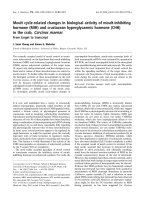The complete chess course from beginning to winning chess 21st century edition (2016)
Bạn đang xem bản rút gọn của tài liệu. Xem và tải ngay bản đầy đủ của tài liệu tại đây (33.67 MB, 479 trang )
The
Complete Chess Course
From Beginning
To
Winning Chess!
by
Fred Reinfeld
21st Century Edition
Fred Reinfeld Chess Classics
Peter Kurzdorfer, General Editor
2016
Russell Enterprises, Inc.
Milford, CT USA
The Complete Chess Course
From Beginning to Winning Chess!
© Copyright 2016 Donald Reinfeld and Judith Reinfeld
Fred Reinfeld Chess Classics – Peter Kurzdorfer, General Editor
ISBN: 978-1-941270-24-0
Ebook ISBN: 978-1-941270-25-7
All Rights Reserved
No part of this book may be used, reproduced, stored in a retrieval system or transmitted in any manner or form whatsoever or by any
means, electronic, electrostatic, magnetic tape, photocopying, recording or otherwise, without the express written permission from the
publisher except in the case of brief quotations embodied in critical articles or reviews.
Published by:
Russell Enterprises, Inc.
PO Box 3131
Milford, CT 06460 USA
The publisher and editor wish to express their thanks to David MacEnulty for his permission to use the explanation of English Algebraic
Notation as set forth in his book My First Book of Chess Tactics.
Cover design by Janel Lowrance
Printed in the United States of America
Table of Contents
From the Editor
Introduction
Book One – The Basic Rules of Chess
How the Pieces Move
Check and Checkmate
Castling
Additional Powers of the Pawn
How the Moves Are Recorded
Relative Values of the Chess Forces
How Games Are Drawn
Book Two – The Nine Bad Moves
(1) Neglecting Development of Your Pieces
(2) Exposing Your King to Attack
(3) Making Too Many Queen Moves in the Opening
(4) Grabbing Pawns Thoughtlessly
(5) Weakening Your Castled Position
(6) Getting Pinned
(7) Failing to Guard against Captures
(8) Underestimating Your Opponent’s Threats
(9) Losing a Won Game
Book Three – How to Play the White Pieces
(1) How to Control the Center
(2) How to Exploit Your Superior Development
(3) How to Exploit Your Superior Mobility
(4) How to Exploit Black’s Premature Opening Up of the Position
(5) How to Exploit Black’s Premature Counterattack
(6) How to Exploit Black’s Weakening Pawn Moves
(7) How to Exploit Black’s Errors of Judgment
(8) Opening Mistakes White Should Avoid
Book Four – How to Play the Black Pieces
(1) How to Exploit White’s Weaknesses
(2) How to Seize the Initiative
(3) How to Play against Gambits
(4) How to Defend against a Powerful Attack
(5) How to Seize the Attack
(6) Opening Mistakes Black Should Avoid
Book Five – How to Win When You’re Ahead
(1) Superior Force Should Win!
(2) The Power of Pawn Promotion
(3) King and Pawn Endings
(4) Endgames with a Piece Ahead
(5) Endgames with the Exchange Ahead
(6) Rook and Pawn Endings
(7) Endings with Minor Pieces
(8) Sundry Endings
(9) How to Simplify into a Won Ending
(10) Exceptions: Material Advantage Doesn’t Always Win
(11) Beware of Overconfidence!
Book Six – How to Fight Back
(1) Counterattack – How to Meet the Crisis
(2) Resourceful Defense – How to Simplify
(3) Half a Point Is Better than None
(4) The Defense Fumbles
(5) How to Fight Back: Practical Examples
(6) Point of No Return
Book Seven – How to Play the e-pawn Openings
Center Game
Danish Gambit
Bishop’s Opening
Vienna Game
King’s Gambit
King’s Gambit Declined
Falkbeer Counter Gambit
Latvian Counter Gambit
Philidor’s Defense
Petroff’s Defense
Scotch Game
Ponziani Opening
Hungarian Defense
Giuoco Piano
Evans Gambit
Two Knights’ Defense
Max Lange Attack
Four Knights’ Game (including Three Knights’ Game)
Ruy Lopez
French Defense
Sicilian Defense
Caro-Kann Defense
Alekhine’s Defense
Scandinavian Defense
Nimzovich Defense
Pirc Defense
Book Eight – How to Play the d-pawn Openings
Queen’s Gambit Declined
Albin Counter Gambit
Queen’s Gambit Accepted
Miscellaneous Double d-pawn Openings
Nimzo-Indian Defense
Queen’s Indian Defense
King’s Indian Defense
Grünfeld Defense
Blumenfeld Counter Gambit
Budapest Defense
Benoni Defense
Dutch Defense
Réti Opening
Catalan System
English Opening
Bird’s Opening
Editorial Notes
From the Editor
Mid-20th century best-selling author Fred Reinfeld introduced thousands of players to the
wonderful game of chess through his tireless efforts. His books were ubiquitous and covered every
conceivable aspect of the royal game.
I was one of countless chess players representing several generations who grew up surrounded by
Reinfeld books. We couldn’t get enough of them! He not only taught us how to play the game well, but
also implanted in us his enthusiastic passion for learning the game.
Fred’s books are peppered throughout with words and phrases in italics to emphasize ideas.
Moves are punctuated with single, double, and even triple exclamation marks and question marks to
span the entire spectrum of emotions the moves conjure up.
He had a way of reducing the most intricate, complicated combinations to their basic components.
After Reinfeld explains a combination, it makes sense.
Thus I am pleased and honored to be a part of bringing back my old mentor to new generations of
chess players. Russell Enterprises Inc. is engaged in a project of resurrecting the immortal Reinfeld
classics, republishing them with the modern algebraic notation in place of the archaic English
descriptive notation that was popular years ago to make them accessible to 21st century chess
players.
This undertaking, begun under General Editor Bruce Alberston, has been passed on to me. So I get
to reread these wonderful old books, change the notation in ChessBase, type up Fred’s snappy prose,
and look out for potential errors.
The few analytical errors that crop up from time to time are easily checked with the monster chess
engine Fritz, which Fred never had access to. In those far-off pre-computer days, you analyzed each
and every position, including any variations you thought up, with nothing more than a board and
pieces, using your knowledge of the pieces’ potential.
Thus the few errors are no reflection on the author’s ability or knowledge at all. I have called
attention to only the most egregious ones, indicated by an asterisk, and appearing on page 288. They
certainly do not detract at all from the fresh charm he imparts on each and every position he looks at.
The Complete Chess Course in particular was originally brought out as a series of separate
books that Fred later combined. The only part that is slightly out of date is his treatment of the
openings, which are rather naïve by modern standards; however, that should make no difference at the
intermediate or even national master level, as I know all too well.
Absorb the material included in this volume and you will play chess at a fairly high level. Or read
through it all and enjoy Fred’s masterful explanations; you will certainly be entranced by his
enthusiasm for the intricate relationships the pieces experience in the context of a game or even a
standout plan or combination.
The section on notation is the only portion of this work that Fred Reinfeld did not write. Since he
used the old English descriptive notation exclusively, that section has been replaced with the gracious
permission of David MacEnulty from his My First Book of Chess Tactics.
Peter Kurzdorfer
Olean, New York
October 2015
Introduction
Although seven of the eight sections of this book were originally published as separate volumes,
they were written with their coordination as a complete chess course in mind. Conveniently prefaced
now by a new summarized review of the basic elements of chess, the resulting comprehensive whole
provides the instruction that any chessplayer needs to develop a respectable degree of skill.
The integrated progression of subjects is treated in the following order. A player who knows the
elements but little more about chess may not need the introductory steps revealed in Book One, but he
does need to be warned about the types of mistakes – neglected development and the like – that
beginning and intermediate players make so frequently. He can then go on to study opening play in its
larger aspects, and examine its consequences in the ensuing middlegame. From this point he proceeds
to study the endgame stage, which evolves out of the middlegame previously studied. And finally,
having seen the logical relationship which binds together opening, middlegame, and ending, the
student is now ready to go back to the initial stage and study the chief openings in rewarding detail.
With this overall scheme in mind, the reader is in a better position to appreciate the detailed
treatment in each section.
Book One is a summary of chess fundamentals that provides the first springboard into the “royal”
game for beginners, and also serves as a refresher for the more advanced player.
Book Two is a study of the nine most common mistakes made by chessplayers. These include such
typical errors as failing to guard against hostile captures, underestimating the opponent’s threats, and
making pawn moves that weaken the castled position. Many examples are given to show how these
and other mistakes prove disastrous in the opening and middlegame.
Now that the reader has been made aware of the kinds of mistakes he must avoid, he is ready to
study the problem of planning the opening so as to get a promising middlegame position. First the
subject is treated from White’s point of view (Book Three). Dealing with such problems as control of
the center, how to exploit superior development and mobility, and the like. But it is at least equally
important to deal with opening problems from Black’s point of view, and this brings us to Book Four;
here problems of counterattack and defense are emphasized.
These studies of middlegame play lead logically to a treatment of the endgame stage, for whatever
happens in the final part of the game is the consequence of what happened earlier in the opening and
middlegame. As a rule, the chief practical problem of endgame play is how to win with a material
advantage which has been obtained in the middlegame. In Book Five the different types of endings are
classified and studied; many practical examples are explained, and the reader acquires an excellent
grasp of the vital problem of converting a material advantage into victory.
But to know how to make use of advantages is not enough; so in Book Six we go on to the related
problem of how to make the most of disadvantageous positions. This section contains many valuable
pointers that will help the reader to salvage many an apparently lost game.
Now that opening, middlegame, and endgame have been surveyed, what remains? It is now time
to survey the chess openings in some detail, paying particular attention to the way in which opening
moves are intertwined with the ensuing middlegame play. This material appears in Books Seven and
Eight. Each opening is presented with explanations of is basic ideas – the plans of each player, their
middlegame goals, the clash that follows their attempts to enforce their disparate conceptions.
Throughout, my aim has been to give the reader a better idea of the fine points of chess as it is
played by the masters. The appreciative comments I have had from readers encourage me to believe
that a much wider circle of new readers will enjoy this material and apply it profitably in their own
games.
Fred Reinfeld
Book One
The Basic Rules of Chess
Chess is played by two opponents, “White” and “Black,” who take turns making their moves.
White always makes the first move. The chessboard (Diagram 1) has eight horizontal rows (“ranks”)
and eight vertical rows (“files”). Each row is therefore made up of eight squares.
All 64 squares are used in the play, and in order to make it easier to tell them apart, they are
alternately light colored (“light squares”) and dark colored (“dark squares”). (D)
The Chessboard
At the beginning of a game, each player has 16 chessmen, always placed as in Diagram 2. (D)
The Opening Position
White always takes the light colored chessmen; Black has the dark colored chessmen. The names
of the forces shown in Diagram 2 are:
An important point to remember is that in the opening position the right-hand corner square
nearest to White must be a light square.
Another important point about the opening position: the two queens face each other along the same
vertical row (“the d-file”). Each queen is placed on a square of its own color, the white queen on a
light square, the black queen on a dark square.
Both kings likewise face each other across the e-file.
The king bishop is placed next to the king, on the f-file.
The king knight is placed next to the king bishop, on the g-file.
The king rook is placed next to the king knight, on the h-file.
The queen bishop is placed next to the queen, on the c-file.
The queen knight is placed next to the queen bishop, on the b-file.
The queen rook is placed next to the queen knight, on the a-file.
The white pawns are set out on the second row (“the second rank”), in front of the pieces just
named.
The black pawns are set out on the seventh row (“the seventh rank”), in front of the pieces just
named.
Each pawn is named for the file it stands on.
Thus, the pawn on the e-file (where the kings begin the game) is the e-pawn.
How the Pieces Move
Each of the men moves in a different way. In describing the moves it is necessary to refer to
ranks, files, and also diagonals. (A diagonal is a row of squares of the same color all going in the
same direction. In Diagram 2 the row of light squares from White’s king rook to Black’s queen rook
is a diagonal.)
The King
The king (subject to limitations that are described later on) moves one square in any direction.
(D)
White’s king has eight possible moves, indicated by an “X.”
The king captures the same way it moves; when it captures an enemy piece it displaces that piece
(occupies the square of the captured unit). (D)
White’s king can capture any one of the black men.
The Queen
The queen is the most powerful of all the chess forces. Like the king, the queen can move in any
direction – but with this important difference: the queen can move the whole length of any available
line, as long as there is no obstacle in the way. (D)
The queen can move to any of the squares indicated by an “X”; it moves in only one direction at a
time.
There are two possible obstacles: friendly pieces, which the queen cannot displace or leap over;
or enemy pieces, which can be captured by displacement. (D)
The white queen can capture the black rook or bishop or either black knight.
The Rook
The rook (next most powerful piece after the queen) moves horizontally (on ranks) or vertically
(on files) – one direction at a time. (D)
The rook can move to any square indicated by an “X.”
The rook captures hostile pieces by displacement, but it cannot displace or leap over its own
forces. The rook captures in the same way it moves. (Some players call the rook a “castle,” but
“rook” is the proper term.) (D)
The rook can capture the bishop or knight, but not the pawn.
The Bishop
The bishop, moving in one direction at a time, moves and captures diagonally. (D)
The bishop can move to any of the squares indicated by an “X.”
The bishop captures hostile pieces by displacement. It cannot displace or leap over its own
forces. (D)
The bishop can capture either of the black pawns.
The Knight
The knight is the only piece that can leap over other units – his own or the opponent’s. The knight
is also the only piece that has a move of fixed length. It moves a total of three squares – in either one
of two ways:
(a) One square forward or backward; then two squares to the right or left.
(b) One square to the right or left; then two squares forward or backward.
The knight captures only on the terminal square of his move, displacing the piece it captures. (D)
The knight has the option of moving to any square indicated by an “X.”
This is one of the eight possible moves available to the knight in Diagram 11.
Note that the knight changes the color of its square each time it moves. It goes from a light square
to a dark square or from a dark square to a light square. (D)
The white knight can capture Black’s bishop.
The knight leaps over two pawns to capture the most distant pawn.
The Pawn
The pawn is the only unit that is limited to moving in only one direction: straight ahead.
With one exception (to be noted shortly), a pawn moves one square forward unless its path is
blocked by one of its own units or by a hostile unit.
The path for white pawns (as seen in Diagram 2) is directly forward from the opening position.
How a white pawn moves is shown in detail on Diagrams 15 and 16. (D)
The white pawn is about to move.
The white pawn has moved.
The path for black pawns (likewise seen in Diagram 2) is also directly forward from the opening
position. How a black pawn moves is shown in Diagrams 17 and 18. (D)
The black pawn is about to move.
The black pawn has moved.
The pawn has one important option. When any pawn is moved from its opening position – even if
this occurs at a late stage of the game – that pawn on its first move has the option of moving one
square or two. Thus, in Diagram 2 (the opening position) all the pawns, while on the second rank (for
White; seventh for Black) have the option of moving one square or two. (D)
White has accepted his option by advancing his e-pawn two squares.
Black has done likewise.
White has accepted the option of advancing his e-pawn two squares. Black, however, has advanced
his d-pawn one square.
The pawn’s capturing methods differ from the way it moves.
The pawn moves by advancing straight along a file. In capturing, however, the pawn can take a
hostile unit only if it is located on either of the diagonally-forward adjoining squares – that is, one
square forward to the right or left. (D)
The white pawn can capture the black bishop.
The pawn cannot capture a hostile unit which is directly in front of it. (D)
The white pawn cannot capture the black bishop.
Check and Checkmate
The king is the most important piece in chess.
The basic method of winning a game of chess is to attack the hostile king in such a way that it
cannot escape. This is called “checkmate.” (The king is actually not captured; its inability to escape
from attack is what constitutes the checkmate.)
Any attack by a piece or pawn directly on a king is called a “check.” When a king is checked, it
must immediately get out of check. The king cannot be allowed to remain in check.
If it is a player’s turn to move and his king is not in check, he cannot make any move that exposes
the king to check. The king must never come within the capturing range of hostile pieces.
There are three ways to get out of check:
(1) to capture the unit that is giving check;
(2) to move the king out of the line of attack – but not into the line of attack of some other unit;
(3) to interpose one of your own units between the king and the hostile unit that is giving check.
If none of these three methods can be applied, then the king is checkmated.
In Diagrams 23 and 24 the black king was in check, but it was possible to get out of check. In
Diagram 25 the attacked king is able to escape; but in Diagram 26 the attacked king is checkmated.
(D)
White’s queen is checking the black king. Black has a choice of three different ways of getting his
king out of check.
Black has captured the white queen, getting out of check. Black could also have moved his king, or
interposed his rook.
Black’s king is checkmated. White’s queen is giving check and Black’s king cannot capture the
white queen, which is protected by a white bishop. Having no flight square, or way of interposing
a friendly unit, Black’s king is trapped.
Black’s king is in check from White’s rook but it has a “loophole.” By playing his king diagonally
forward to the right, Black escapes from the check.
The positions in Diagrams 26, 27, and 28 are all examples of checkmate. In each case the
checking piece cannot be captured; the attacked king cannot move out of the capturing range of the
hostile forces; and no friendly unit can be interposed on the line of attack between the checking unit
and the checked king. (D)
Black’s king is in check from White’s rook and has no escape, as its own pawns block the exit. This
is an example of checkmate.
White’s king is checkmated. White has no escape from the black bishop’s check. Note that Black’s
knight and bishops command all the possible squares available to White’s king, and White cannot
interpose any of his own units.
Discovered Check
This is a special kind of check, caused by removing a unit to unmask a line of attack by another
unit. For example, in Diagram 29 White’s bishop can give check without moving; the check is
“discovered” by moving the white rook which has been blocking the diagonal. The result appears in
Diagram 30. (D)
White can give a discovered check with his bishop by moving his rook.
By moving his rook, White has opened up an attacking line for a discovered check by his bishop.
Double Check
This is a discovered check with an added feature: the piece that unmasks an attacking line for the
discovered check also gives check. (D)









